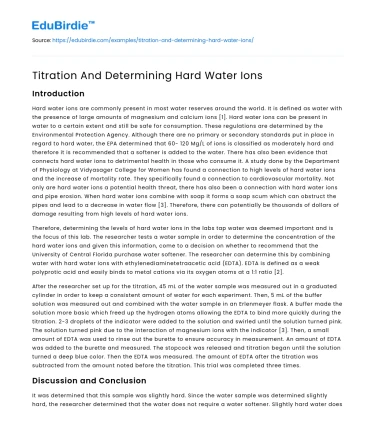Introduction
Hard water ions are commonly present in most water reserves around the world. It is defined as water with the presence of large amounts of magnesium and calcium ions [1]. Hard water ions can be present in water to a certain extent and still be safe for consumption. These regulations are determined by the Environmental Protection Agency. Although there are no primary or secondary standards put in place in regard to hard water, the EPA determined that 60- 120 Mg/L of ions is classified as moderately hard and therefore it is recommended that a softener is added to the water. There has also been evidence that connects hard water ions to detrimental health in those who consume it. A study done by the Department of Physiology at Vidyasager College for Women has found a connection to high levels of hard water ions and the increase of mortality rate. They specifically found a connection to cardiovascular mortality. Not only are hard water ions a potential health threat, there has also been a connection with hard water ions and pipe erosion. When hard water ions combine with soap it forms a soap scum which can obstruct the pipes and lead to a decrease in water flow [3]. Therefore, there can potentially be thousands of dollars of damage resulting from high levels of hard water ions.
Therefore, determining the levels of hard water ions in the labs tap water was deemed important and is the focus of this lab. The researcher tests a water sample in order to determine the concentration of the hard water ions and given this information, come to a decision on whether to recommend that the University of Central Florida purchase water softener. The researcher can determine this by combining water with hard water ions with ethylenediaminetetraacetic acid (EDTA). EDTA is defined as a weak polyprotic acid and easily binds to metal cations via its oxygen atoms at a 1:1 ratio [2].
Save your time!
We can take care of your essay
- Proper editing and formatting
- Free revision, title page, and bibliography
- Flexible prices and money-back guarantee
After the researcher set up for the titration, 45 mL of the water sample was measured out in a graduated cylinder in order to keep a consistent amount of water for each experiment. Then, 5 mL of the buffer solution was measured out and combined with the water sample in an Erlenmeyer flask. A buffer made the solution more basic which freed up the hydrogen atoms allowing the EDTA to bind more quickly during the titration. 2-3 droplets of the indicator were added to the solution and swirled until the solution turned pink. The solution turned pink due to the interaction of magnesium ions with the indicator [3]. Then, a small amount of EDTA was used to rinse out the burette to ensure accuracy in measurement. An amount of EDTA was added to the burette and measured. The stopcock was released and titration began until the solution turned a deep blue color. Then the EDTA was measured. The amount of EDTA after the titration was subtracted from the amount noted before the titration. This trial was completed three times.
Discussion and Conclusion
It was determined that this sample was slightly hard. Since the water sample was determined slightly hard, the researcher determined that the water does not require a water softener. Slightly hard water does not contain high enough levels of water ions to cause much damage. The results of this experiment gave the university key information for safety and cost effectiveness.
During the experiment, the researcher found it difficult to read the burette measurements. Therefore, it is recommended to place a white piece of paper behind the burette in order to see the lines more clearly. One aspect of the experiment that was more difficult to control was determining when the water/EDTA solution was blue enough to stop titration. This could have affected the accuracy of the results.
References
- Sengupta, P. (2013, August). Potential Health Impacts of Hard Water Ions. Retrieved February 22, 2019, from https://www.ncbi.nlm.nih.gov/pmc/articles/PMC3775162/
- Spotz, Kristen. 'A Titration for the Determination of Ions in Water: The Hard Truth.'
- Water Quality Association. (2016). Hardness. Retrieved February 22, 2019, from https://www.wqa.org/learn-about-water/perceptible-issues/scale-deposits
Did you like this example?
Make sure you submit a unique essay
Our writers will provide you with an essay sample written from scratch: any topic, any deadline, any instructions.
Cite this paper
-
APA
-
MLA
-
Harvard
-
Vancouver
Titration And Determining Hard Water Ions.
(2022, February 21). Edubirdie. Retrieved April 10, 2025, from https://hub.edubirdie.com/examples/titration-and-determining-hard-water-ions/
“Titration And Determining Hard Water Ions.” Edubirdie, 21 Feb. 2022, hub.edubirdie.com/examples/titration-and-determining-hard-water-ions/
Titration And Determining Hard Water Ions. [online].
Available at: <https://hub.edubirdie.com/examples/titration-and-determining-hard-water-ions/> [Accessed 10 Apr. 2025].
Titration And Determining Hard Water Ions [Internet]. Edubirdie.
2022 Feb 21 [cited 2025 Apr 10].
Available from: https://hub.edubirdie.com/examples/titration-and-determining-hard-water-ions/
copy






 Stuck on your essay?
Stuck on your essay?

